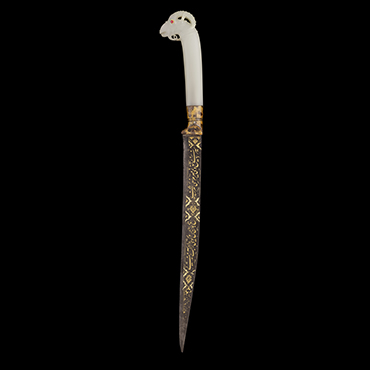Exquisite refinement
Inscribed
میزینی تیغ و نمی میرم زهی شرمندگی تیغ جان بخش تو گوئی دارد آب زندگی
You strike with the blade and yet I do not die—what a disgrace!
One would say that your soul-bestowing blade has the water of life.
The blade of this dagger is decorated with contrasting designs on either side, each finely engraved and inlaid with three different colors of gold, achieved by varying the proportions of silver and copper in the alloy. One side depicts mythical creatures and pheasants set against a floral background, while the other is inscribed with a Persian rhyming couplet. The “water of life” mentioned in the poem refers to the rivers of Paradise described in the Holy Qur’an (Muhammad, 47:15 and Al-Kawthar, 108:1). It is also an allusion to the swirling shades of gray visible on the surface of watered steel.
Both the animal imagery and the elegant nasta‘liq inscription are characteristic of Safavid style. Tabriz, once the capital, was a center of fine metalworking, although the blade could equally have originated from an Ottoman imperial workshop. The large gold-filled leaf shape that divides the inscription is reminiscent of a knife made for Ottoman ruler Ahmed I (r. AH 1011–26/1603–17 CE). Historical records indicate that the court workshops of Istanbul employed knife-makers, goldsmiths, and inlayers, many of whom were Persians, either willingly or as prisoners after the sack of Tabriz in AH 920/1514 CE. The hilt, carved in North India, is made of white jade, a material most prized at the Mughal court. It is intricately fashioned into a highly naturalistic sheep’s head, complete with curved, ribbed horns and a small tuft of hair beneath its chin. The remarkable skill is evident in the detailed ropes and knots of the sheep’s halter and tether, carved meticulously despite the jade’s hardness. Further enhancing its beauty are the ruby eyes, set in kundan style to avoid using heat on the jade. This design is comparable to the ibex or ram’s head finial on the small lobed white jade dish in the Al Thani Collection.
Exquisite refinement
Dagger
Türkiye or Iran, c. AH 1008/1600 CE (blade), India, 11th century AH/17th century CE (hilt)
Steel, gold, jade, rubies, l. 31.4 cm
Furusiyya Art Foundation, R-332

